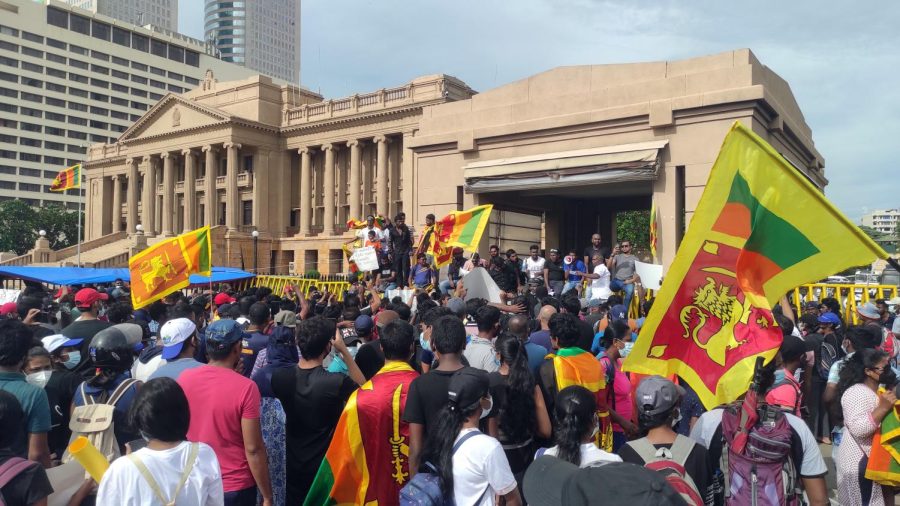Burdened By the War, Many Countries Find Themselves in an Economic Crisis
Anti-government protest for economic action in Sri Lanka on April 13, 2022 in front of the Presidential Secretariat. Image via. Wikimedia Commons
May 27, 2022
Burdened by COVID, the war in Ukraine, and their problems, many small countries have found themselves further sinking into debt. Many countries have had economic problems before but the difference here is that many of these smaller countries are finding themselves bankrupt.
Governments, in an ideal world would pay their obligations with money they earned from taxes and investments. Although, in reality, governments often find themselves in debt after issuing bonds with the promise of paying them back along with interest at the maturity rate. These national debts are created by both internal and external debts and are commonly referred to as sovereign debt. While internal debt can be solved by raising taxes and printing more money, dealing with external debts can be more difficult as they need to be paid in foreign currency, a form out of the government’s control.
Although, debt isn’t the only contributing factor to possible bankruptcy. A country’s history of financial responsibility, including past defaults (caused by “the inability or reluctance of a country to fulfill its debts), and political conflicts also contribute a fair share to the economic struggles of countries.
When an individual or corporation goes bankrupt, their assets are usually just seized, but the result is much different when it comes to countries. A country cannot have its assets seized by itself and cannot be made to pay a fee, as it doesn’t have the money to.
However, bankruptcy isn’t always the first result when a country finds itself with serious debts. But when a country does go bankrupt, the International Monetary Fund or IMF is a good place to go. Members of the IMF frequently look to the IMF for help as it provides not only financial resources but also technical experience. Nonetheless, the financial relief that the IMF can provide also typically comes with strings attached such as having to reduce spending, currency depreciation, and trade liberalization.
Since the beginning of the pandemic, nearly 5 million people have slipped into poverty as estimated by the World Bank and inflation rates have risen severely. Governments of many countries have found themselves creating money to pay off foreign debts and domestic loans, all of which contribute to the rise of inflation.
Sri Lanka is one of these countries that has found itself in the middle of a severe financial crisis with many predicting the country will declare bankruptcy this year. As explained by India Times, the reason for the bankruptcy is intensified by “high government spending and tax cuts depleting state income, massive loan obligations to China, and foreign exchange reserves at their lowest levels in a decade, as well as the immediate impact of the Covid issue and the loss of tourists.”
In November, Sri Lanka found its inflation at a record high of 11.1 percent, which made it difficult even for those who were previously financially comfortable to put food on the table. Many basic items such as rice and sugar were out of reach, and to hopefully provide some relief to citizens, the military was given the power to regulate the prices of the items. Unfortunately, these efforts were proved unsuccessful.
Since the end of March, Sri Lanka has seen many protests between pro-government supporters and those calling for an immediate change in authority. Sri Lanka’s total foreign debt as of May 9, 2022, was over 44 billion dollars and rising prices and tax cuts make it so that the nation has as little as 50 million dollars of usable foreign reserves.
The government has since gone to the IMF for a bailout and hopes to secure emergency assistance. The IMF responded by telling Sri Lanka that “its progress would depend on negotiators on debt restructuring with creditors.”
With prices rising and food supply running out, farmers should be planting more crops, but the expenses for the planting of crops have risen to a point where many farmers are unable to cover the prices leading to planting occurring less frequently. This means that Sri Lanka is more reliant on imports that they don’t have the money for. Along with the less frequent imports and general food inflation running at 50%, authorities have also announced country-wide power cuts.
This has made Sri Lanka the first country to fall under the economic pressures triggered by the war in Ukraine but it’s unlikely to be the last, with nearly 107 countries following closely.







